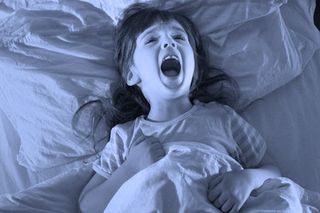
How to Deal With Night Terrors in Kids
They’re not just bad dreams, but they’re usually nothing to worry about.

It can be hard to see your kid experience night terrors, or sleep terrors, but the first thing to know is that they are usually more frightening to parents than they are to the child having them. They are generally not dangerous, if you take similar precautions you would for a child who sleepwalks. But of course, regular night terrors can disrupt an entire family’s sleeping patterns, so read on to understand how you can best help your kid manage them.
What to know about night terrors in kids
Night terrors are not nightmares. Comforting your child after they wake from a nightmare is a fairly standard process, but sleep disorders like night terrors are more complicated, and your child may appear inconsolable. Keep reading to understand what makes night terrors different.
Your child won’t remember the night terror in the morning. Unlike adult night terrors, night terrors in kids are usually forgotten immediately after the fact. For this reason, a child may seem much less affected by sleep terrors than the adults around them.
Night terrors happen in the first part of the night. Unlike nightmares, sleep terrors occur in the first stage of REM sleep, in roughly the first 90 minutes after your child falls asleep.
During the night terror, your child will appear to be awake, but may not respond to you. A child is actually asleep during a night terror, but may have their eyes open, scream or yell, sit upright in bed, move around, and move in an agitated or uncontrollable manner. They may have an increased heart rate and breathing rate, and they may be sweating more than usual. If you do manage to wake your child, they may appear confused.
Most episodes only last a few minutes. But they can last up to 30 minutes.
After it’s over, your child will usually calm down on their own. And fall back into regular sleep by themselves, too.
It’s very likely your child will outgrow night terrors. While night terrors in babies and toddlers aren’t unheard of, the sleep phenomenon typically occurs in children aged 3 to 12 years, with peak onset at 3.5 years. They almost always disappear after age 12.
What to do for night terrors in kids
Pinpoint an external cause. Sleep terrors are still fairly mysterious, but certain factors have been observed to affect them. If your child starts experiencing night terrors after increasing their caffeine intake or taking sleep-altering medication (such as certain antihistamines), try eliminating these possible triggers, if you can, to see if the night terrors go away.
Enforce a regular bedtime. In some cases, simply having your child go to sleep at the same time each night may ease the night terrors. Putting your child to bed earlier than usual may be the best course of action, because sometimes night terrors are brought on by sleep deprivation.
Reduce or increase the room temperature. An ideal temperature will prevent your child from waking up as many times in the middle of the night, and may even stave off night terrors.
Don’t try to shake your child awake. In fact, avoid touching them, as that may even make them react more violently.
Reassure other family members. Sometimes, night terrors can seem more frightening to observers than they are to the child experiencing them, because your child will have no memory of the night terror the next morning. Assure other family members that the night terrors are not indications that your child is in pain or otherwise troubled.
Try scheduled awakenings. Usually, sleep terrors occur at the same time of night. In general, they happen in the first part of the night, when your child is in REM sleep. Note down when the night terrors seem to be happening, and then wake them 15 minutes before that time each night. This may alter your child’s sleep state enough to prevent the night terrors, and when done with regularity, your child may even start waking up on their own.
Move anything potentially dangerous out of reach. Remove any sharp or hard items off the floor, and position yourself in between your child and the bed’s headboard.
Lock doors and windows. Install a gate for the top of the stairs. Because some children sleepwalk during night terrors, this will prevent them from hurting themselves if they do get out of bed.
Speak softly. If your child does sleepwalk during a night terror, calmly reassure them and guide them back to their beds.
See a doctor. If your child has sleep apnea, this may be what’s behind the sleep terrors, and they may stop experiencing them after using a sleep apnea machine. A doctor may also be able to determine if your child has gastric reflux or restless leg syndrome; these conditions might also be responsible for the night terrors. And even if your child is otherwise healthy and no external factors seem to be affecting their sleep, but the night terrors persist and cause distress to either the child or family, consulting a doctor may help you find additional ways to manage them.
Related


New Research Questions ‘Marshmallow Experiment’ As Benchmark In Child Development
